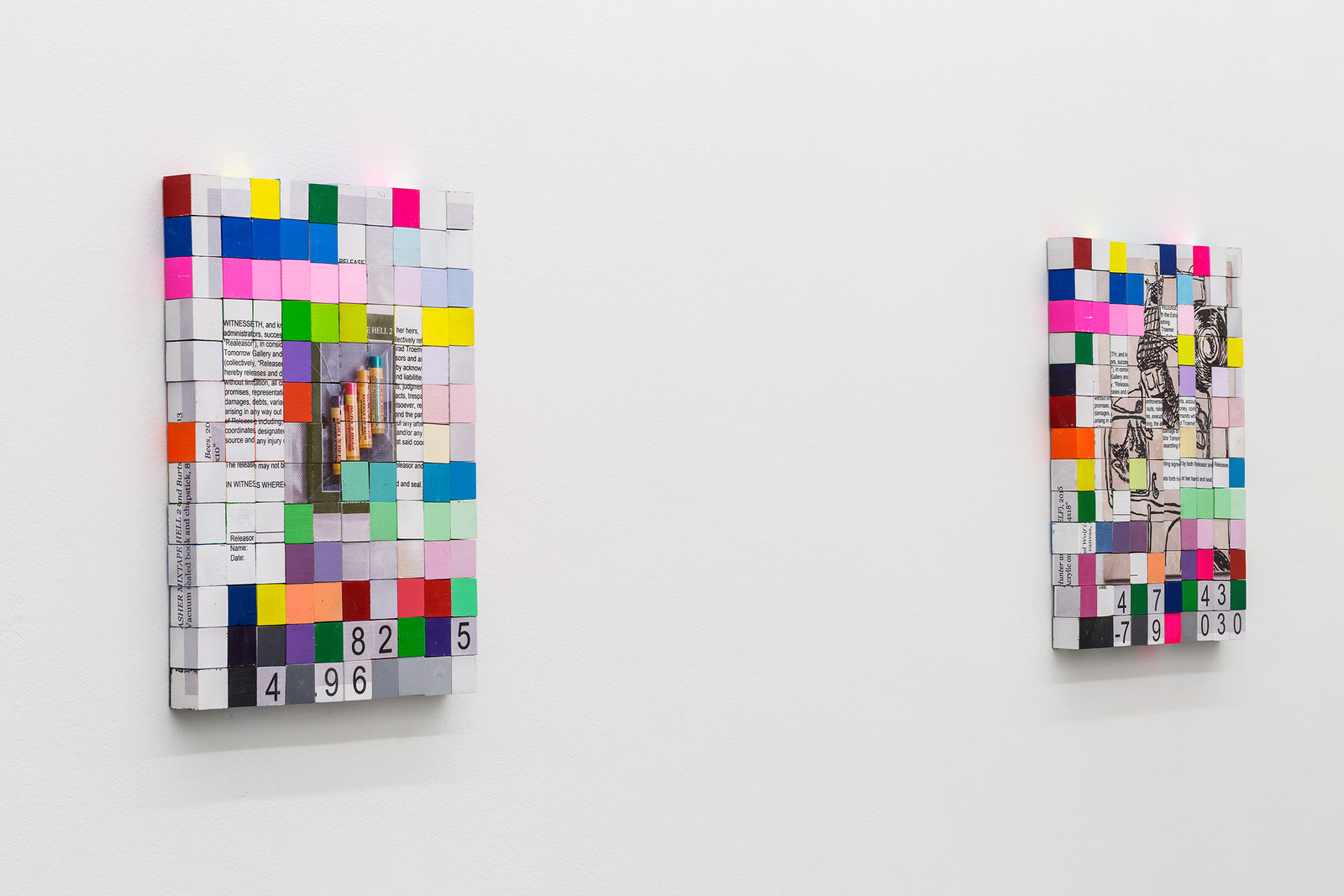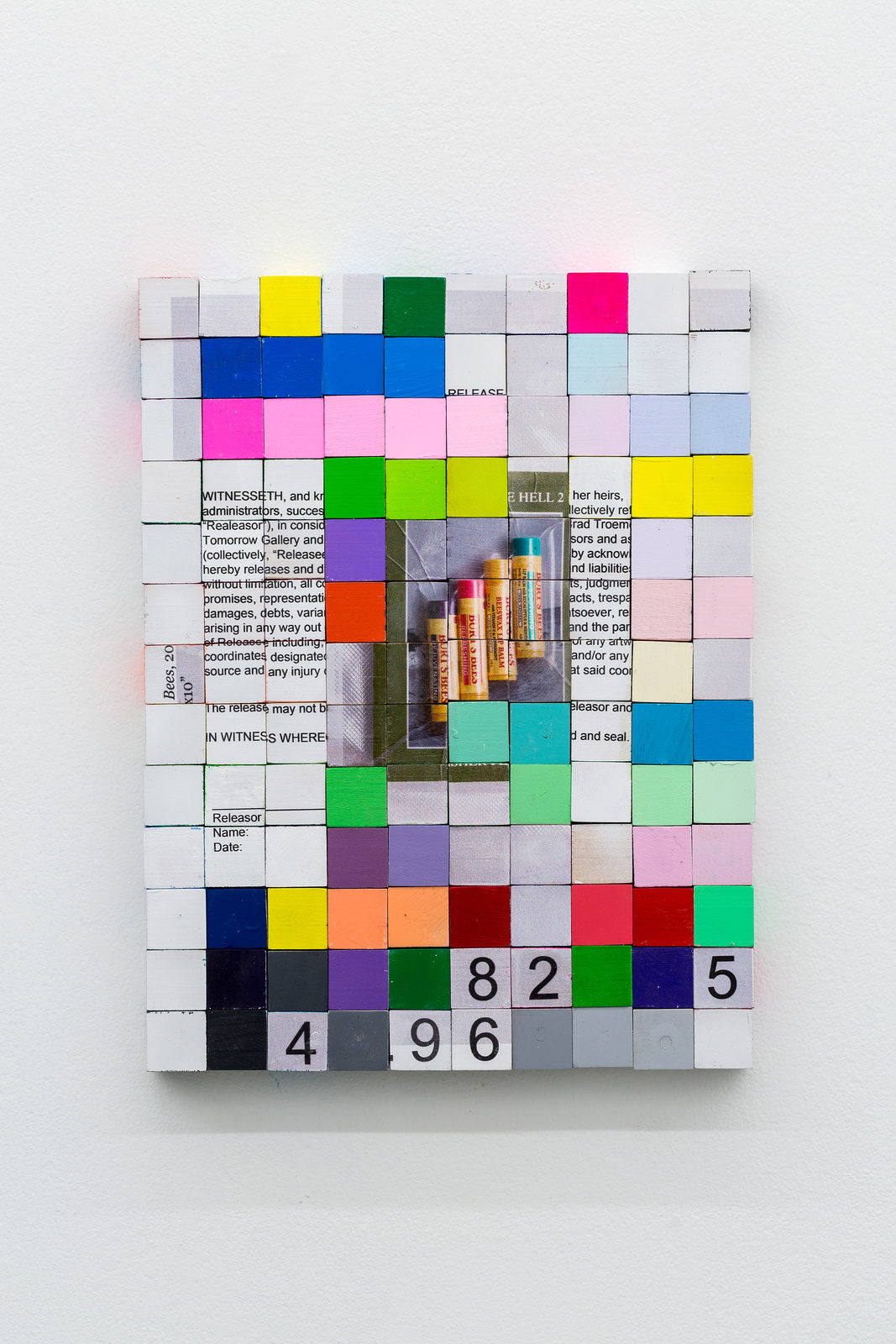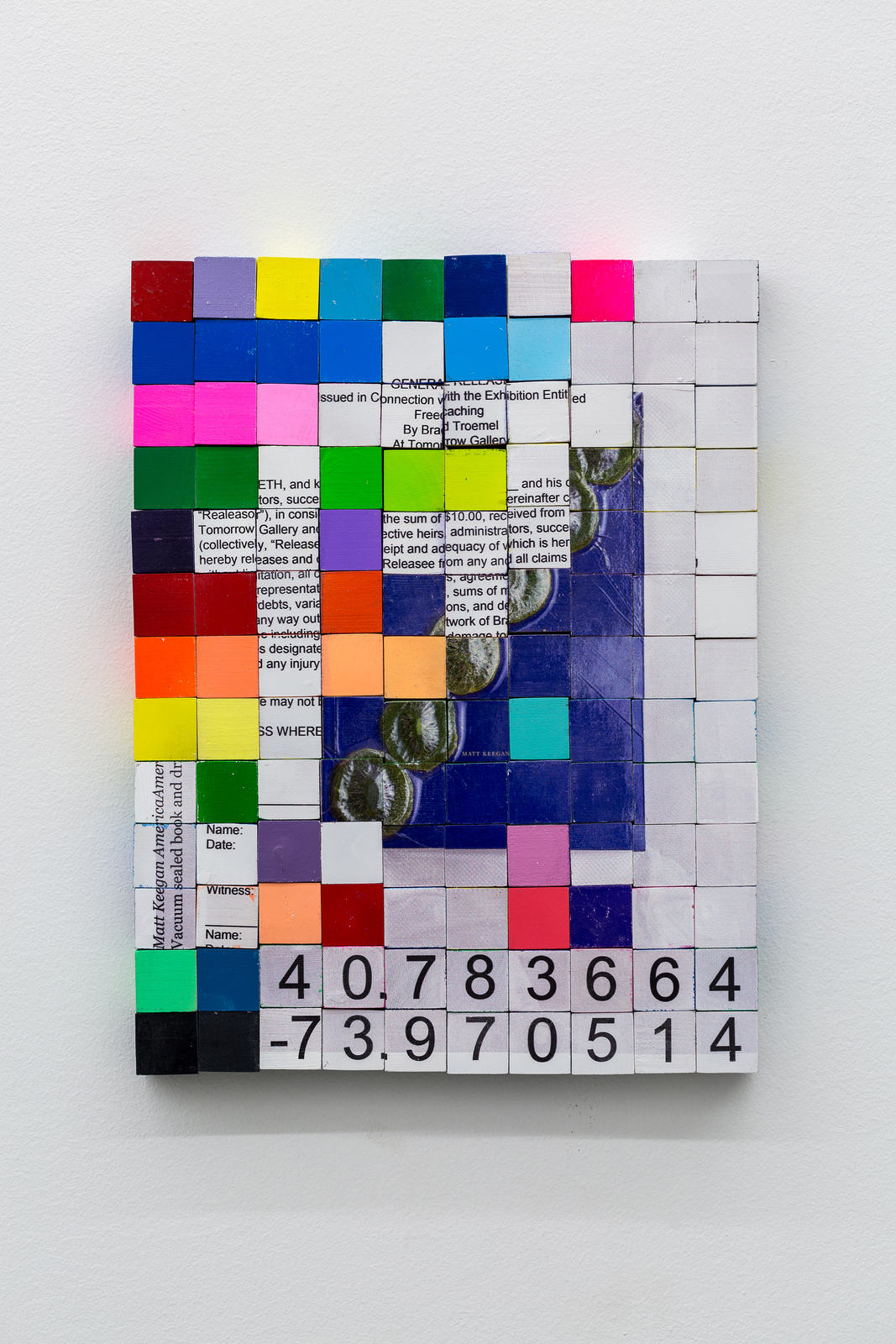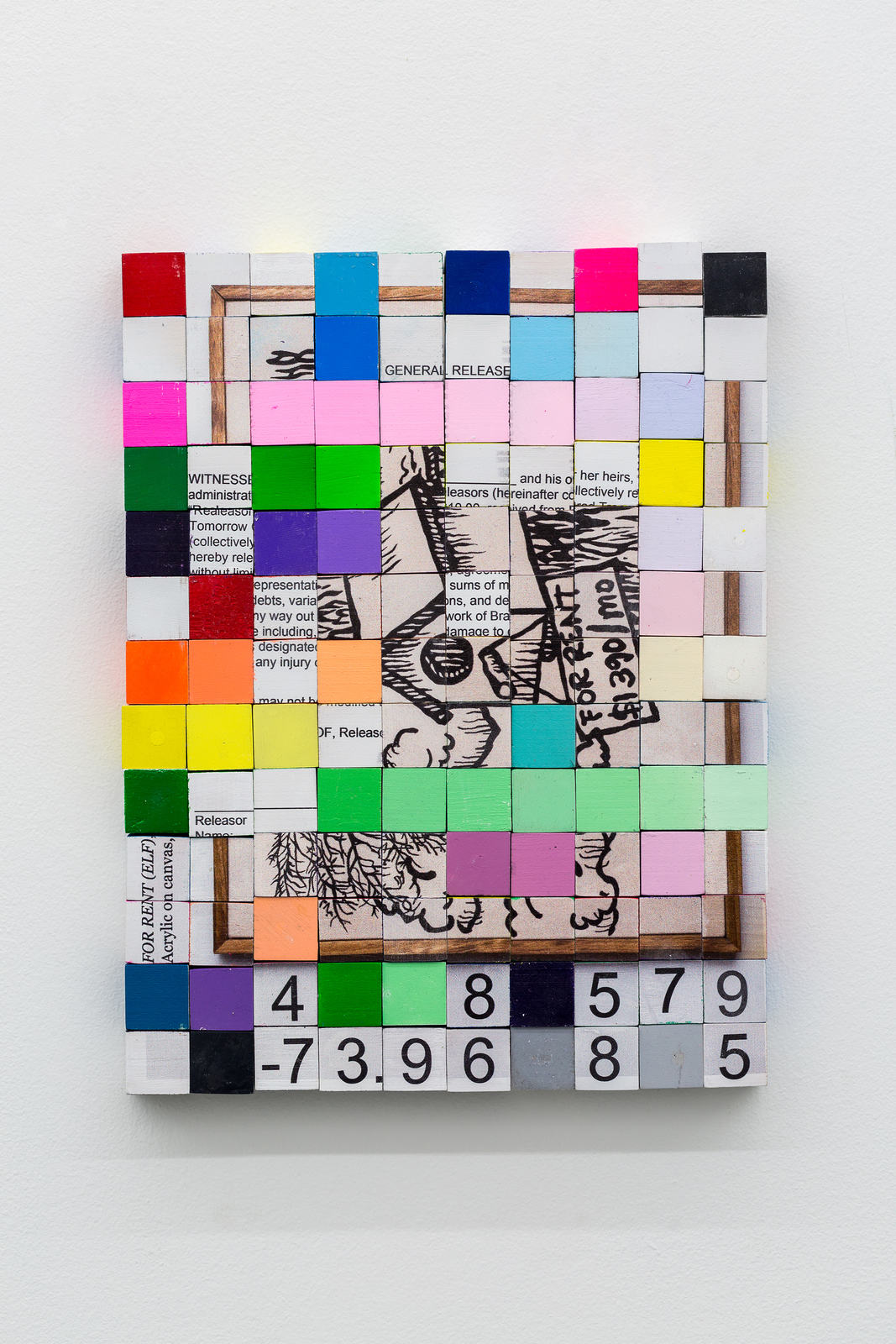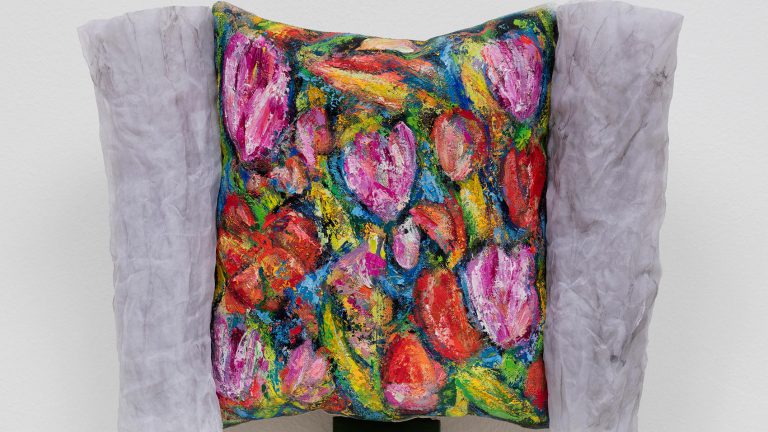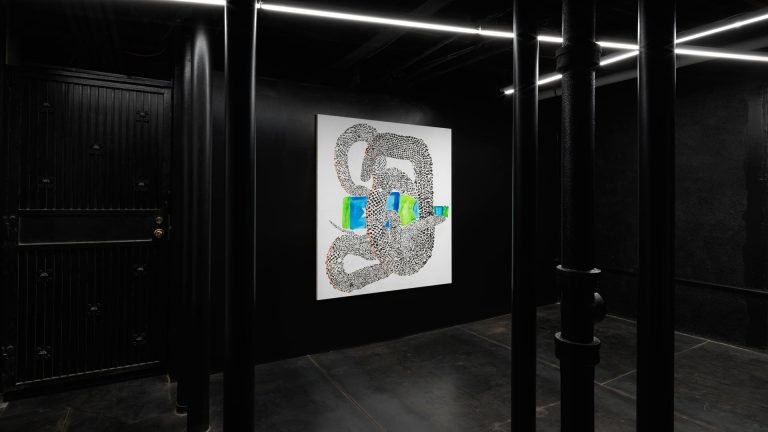Artist: Brad Troemel
Exhibition title: Freecaching
Venue: Tomorrow, New York, US
Date: November 3 – December 9, 2016
Photography: all images copyright and courtesy of the artist and Tomorrow
Artist conceals entire studio inventory in Central Park, presents GPS coordinates as magnetic puzzle certificates of authenticity at Tomorrow. Uses exhibition as proof of concept for discretely utilizing public space as a sharing economy art storage business model.
[Estimated read time: 3 minutes]
Before moving out of my studio I was AirBNBing my apartment to pay for my apartment and subletting my studio to pay studio rent. I slept in one or the other to pay for one or the other. It works, but the problem is that you don’t get to regularly inhabit those spaces and the point of renting those spaces is to inhabit those spaces. In a sharing economy all you own is time, personal space, and mobility until you don’t have any more.
Rhetorical question: What if you could rent out space to others that you don’t live in or own?
I got this idea while I was AirBNBing my Brooklyn apartment for the month of June and staying at my grandparents’ house in Aurora, Illinois. I incredulously downloaded the Geocaching app on my green iPhone5S to see if the surrounding rural area would have any Geocaches available. To my surprise there were TONS of Geocaches sprinkled all throughout the woods. Scenes I’ve passed hundreds of times growing up were full of concealed relics I’d never noticed before, some dating back a decade or more.
Reader: What is Geocaching?
Geocaching has been around since 2000 when the US government loosened restrictions on how precisely civilians could utilize global positioning system (GPS) technology. In an effort to gauge how it worked, people hid objects in far off locations and publicized the coordinates online for others to find. In the mid-aughts Geocaching gained minor acclaim as a wholesome recreational activity focused on outdoor exploration and exercise. Once found, the contents of a Geocache are typically mundane miscellanea like loose change and a log-in scroll kept in a pill bottle; the journey is the destination. Today, this GPS precision is the basis for all proximity-based apps from Tindr to Google Maps to Pokemon Go to Uber.
Rhetorical question: So why hasn’t Geocaching been popularly monetized already like the rest of those apps?
Thought exercise: Imagine if Geocaching’s use of GPS technology, concealment, and open space were applied to passive storage rather than active treasure hunting. Imagine Geocaching as an innovation reshaping the art world’s Freeports – Freecaching if you will. Like works held and traded in Freeports, Freecaching is ownership-through-certificate until physically retrieved. Through Freecaching you could leave art physically protected and concealed in an uninhabited area outside a major center of arts commerce and provide buyers with the exact latitude and longitude of a purchase. Hidden enough so no one could feasibly stumble upon it, but close enough to find within a train ride from the gallery. Collectors could choose to pick their work up or just as comfortably leave it concealed and protected outdoors, knowing with confidence that no one but they and the artist have knowledge of where the work is located. If Freeports are austere, “lights out” facilities where art objects are held in an industrial storage rack, imagine Freecaching as the pastoral, sun-dappled alternative where art is able to be one with the sublime beauty of its natural surroundings, its provenance enhanced with every passing day. If we are to believe an art object retains the aura of the place from whence it came – the artist’s studio – then what of the rest of its life post-exhibition? If an artwork can be changed permanently by where it was made, it can certainly be enhanced or harmed by where it goes on to live its everyday life. Long term art ownership in this sense is akin to farming’s cultivation of an increasingly desirable good. Freecaching carries the ethics of raising your art free range– refuse industrial storage!
In Freecaching, the prefix Free doesn’t just refer to the art objects’ status as being tax-free; it extends to their being in open air, free of a centralized storage location, free of anyone else’s knowledge they exist. Art storage lockers are expensive to rent. Let’s stop competing over barely affordable scraps of art storage and begin taking advantage of space as an overabundant natural resource, perfectly suited to discretely house artworks. Space, it turns out, is everywhere. Even here in New York. That’s why I concealed my studio inventory smack dab in the center of it: Central Park.
Like a stranger sleeping in your bed while you’re away, Freecaching emits the barely audible hum of privately shared use. If the universal etiquette of the commons is to be a temporary fixture (to use and move on from without jeopardizing further shared use by others), the invisibility and transience of Freecaching ensures at least partial adherence to this ideal. What is beautiful about Central Park is the possibility of being lost in an artificial wilderness in the middle of the city. This expanse of man-made nature provides the spatial abundance for art objects to become abstracted information, for large canvases to be compacted into tiny vacuum sealed bags and become GPS coordinates. For Freecaching to work, there must be too much spatial information for us to know each of its parts intimately. Decrypting the existence of these objects between 59th to 110th Streets is dependent on the information presented through certificates on the walls of 106 Eldridge Street, just as those hung certificates are likely decrypted by this press release.
Collector: So if you’re hiding your art out in the park, won’t that leave it susceptible to the elements? If I actually go pick up the work won’t it be destroyed by then?
All work, no matter its size, is double vacuum sealed in industrial plastic. From here it’s secured and sealed once more. No oxygen, no UV rays, no damage. My studio inventory is in the trees, bushes, rocks, soil, signs, and architecture of the park. It’s fully integrated to the point where only someone with the exact GPS coordinates could ever think of finding it. It will decay at a rate slower than that of work in a storage locker and it will be free of the murky connotations of dealing with a shady Freeport. In fact, I believe in the security of Freecaching as a storage model to the extent that I’ll be releasing the GPS coordinates of several works here at Tomorrow so viewers can go and see for themselves that the work is stored and secured just where the certificates stipulate. Most of the block certificates have the 18 digit GPS coordinates turned away from the viewer, though several GPS coordinates will be made public so even those who don’t purchase work will be able to access offsite locations and experience Freecaching for themselves.
Another artist: So is Freecaching just a way of helping collectors out? Who does Freecaching benefit?
In art, it’s the small businesses whose largest expenses are storage and real estate that stand to benefit the MOST from Freecaching. Small businesses such as an artist like you or me. Or Tomorrow, an independently run exhibition space.
Consider the user benefits to Freecaching: for artists, storage is the deadest weight of all. Stuffed in a rack in the back of a studio, stored work is unviewable, is likely unsold, displaces productive space, and requires payment for the area it takes up. For galleries, allocating storage within real estate is a double bind: a larger, more expensive space may afford you opportunities for larger exhibitions and more sales, but it raises monthly rent costs proportionally. A smaller space may be thriftier but limits the type of programming possible and the amount of work that can fit to sell in the first place. My need to get rid of my studio inventory reflects both of these problems: I have too much work stored in my previous art studio to be able to move it into my current studio apartment without making the living space uninhabitable, which means there’s also too much stored work to move it all into Tomorrow’s modestly sized exhibition space. Freecaching is the solution to both problems. I can alleviate the burden of storage on my apartment while also representationally exhibiting more work in Tomorrow Gallery than could fit inside of it.
Viewer: So if the studio work is Freecached in Central Park then what’s on the walls here at Tomorrow?
Description of works: These are certificates that authenticate my Freecached studio inventory in Central Park. The certificates consist of 10 x 13 (1 inch) rows of wooden blocks. The blocks are magnetized to display up to three different sides of any given block, allowing for customization of display and concealment of the specific corresponding work’s GPS coordinates.
– One of the blocks’ sides features an image of the work Freecached in Central Park and includes that work’s GPS coordinates.
– The next side is a contract for the work featuring my signature and the date.
– The rest of the blocks’ sides are colors set to a pattern to allow for a fully abstracted display or to add visual static in combination with the other two sides.
Obtaining GPS information about the Freecached work requires its owner to solve the puzzle. All three sides will be presented simultaneously throughout the 130 blocks.
Brad Troemel, Freecaching, Geocaching in Central Park
Brad Troemel, Freecaching, Geocaching in Central Park
Brad Troemel, Freecaching, Geocaching in Central Park
Brad Troemel, Freecaching, Geocaching in Central Park
Brad Troemel, Certificate of Authenticity for Freecached: Locked Protestors (ELF), 2016, UV printed and magnetized wood bloks on stainless steel, 10 x 13.25 inches
Brad Troemel, Certificate of Authenticity for Freecached: ASHER MIXTAPE HELL 2 and Burt’s Bees, 2016, UV printed and magnetized wood bloks on stainless steel, 10 x 13.25 inches
Brad Troemel, Certificate of Authenticity for Freecached: ASHER MIXTAPE HELL 2 and Burt’s Bees, 2016, UV printed and magnetized wood bloks on stainless steel, 10 x 13.25 inches
Brad Troemel, Certificate of Authenticity for Freecached: Hunter and Wolf (ELF), 2016, UV printed and magnetized wood bloks on stainless steel, 10 x 13.25 inches
Brad Troemel, Certificate of Authenticity for Freecached: Kansas 2005-P ‘In God We Rust’ Error State Quarter, 2016, UV printed and magnetized wood bloks on stainless steel, 10 x 13.25 inches
Brad Troemel, Certificate of Authenticity for Freecached: Wildlife Analysis and Kiwis, 2016, UV printed and magnetized wood bloks on stainless steel, 10 x 13.25 inches
Brad Troemel, Certificate of Authenticity for Freecached: Michael Godard Breast Cancer Painting, 2016, UV printed and magnetized wood bloks on stainless steel, 10 x 13.25 inches
Brad Troemel, Certificate of Authenticity for Freecached: WE WILL WIN (ELF), 2016, UV printed and magnetized wood bloks on stainless steel, 10 x 13.25 inches
Brad Troemel, Certificate of Authenticity for Freecached: Matt Keegan America America, 2016, UV printed and magnetized wood bloks on stainless steel, 10 x 13.25 inches
Brad Troemel, Certificate of Authenticity for Freecached: FOR RENT (ELF), 2016, UV printed and magnetized wood bloks on stainless steel, 10 x 13.25 inches
Brad Troemel, Certificate of Authenticity for Freecached: Obama Conspiracies (ELF), 2016, UV printed and magnetized wood bloks on stainless steel, 10 x 13.25 inches
Brad Troemel, Certificate of Authenticity for Freecached: Dynamite and Black Cat (ELF), 2016, UV printed and magnetized wood bloks on stainless steel, 10 x 13.25 inches
Brad Troemel, Certificate of Authenticity for Freecached: Counterfeit and Real Princess Di Beanie Baby, 2016, UV printed and magnetized wood bloks on stainless steel, 10 x 13.25 inches
Brad Troemel, Certificate of Authenticity for Freecached: Counterfeit and Real Princess Di Beanie Baby, 2016, UV printed and magnetized wood bloks on stainless steel, 10 x 13.25 inches













